 Every day someone comes to our office with lower back pain (LBP). Often, the person’s primary complaint is that they cannot perform an important daily activity (work, clean, cook, run) because of back pain. However, no group of patients with lower back pain is more eager to recover and return to unrestricted activity than golfers. Dr. Joe Cimochowski and Dr. Dan Sullivan are two good examples of successful return to the sport after spine surgery. I hope this column does not jinx them!
Every day someone comes to our office with lower back pain (LBP). Often, the person’s primary complaint is that they cannot perform an important daily activity (work, clean, cook, run) because of back pain. However, no group of patients with lower back pain is more eager to recover and return to unrestricted activity than golfers. Dr. Joe Cimochowski and Dr. Dan Sullivan are two good examples of successful return to the sport after spine surgery. I hope this column does not jinx them!
LBP is the most common physical problem for amateur golfers. However, professional golfers also are plagued with this problem. For example, recently, Phil Mickelson had to withdraw from Farmers Insurance Open Tournament and Tiger Woods backed out of the Arnold Palmer Invitational at Bay Hill due to lower back pain. Fortunately, PGA professionals benefit tremendously from sport science, physical therapy and fitness programs on tour.
The causes of LBP in golfers, especially in the amateur, are many: poor golf swing mechanics, excessive practice, inadequate warm-up and poor flexibility and conditioning. However, the very nature of the golf swing can create great stress on the structures of the lower back. Forward bending while twisting creates excessive torque on the discs, joints, muscles and ligaments of the lower back.
Tips For Golfing With Lower Back Pain
-
Warm Up – Get to the course early enough to make time to stretch before you play and hit a few balls at the range. Always start with low irons and work up to driver. Take a hot shower before an early morning round and use compression shorts and shirts on cool days. Do Not Bounce or Overstretch! Stretch slowly, holding for 10-20 seconds:
-
Shoulder Overhead Stretch – slide hand up door jam while walking toward wall and raise arm until completely overhead. (See Photo 1)
-
Shoulder Chest Cross Stretch- bring one arm across chest using other arm to pull behind elbow. (See Photo 2)
-
Extend Middle and Lower Back Stretch – place club behind small of back and pinch shoulder blades together. Also, extend lower back against club. (See Photo 3)
-
Rotate Trunk Standing -while standing with an arched lower back and using club behind your back slowly rotate to right, then left. (See Photo 4)
-
Rotate Trunk Lying– lying on back and rotate upper trunk to right and then to left. Repeat rotating lower body right and left with knees bent. (See Photo 5)
-
Lower Back Flexion Stretch –lying on back and bring both knees toward chest. Hold with clasped hands and gently stretch. (See Photo 6)
-
Set Up –
-
Stance - Use stance for balance and power to protect your back. and allow your hips to rotate for less stress on the spine: stand with feet slightly wider than shoulder width, feet turned out 30 degrees, knees bent 10-15 degrees, lower back arched back with buttocks sticking out, head neutral. (See Photo 7)
-
Swing Change – Make swing more compact, flatten swing plane and minimize hip slide, lift left heel up on backswing and right heel on follow-through to protect lower back (for right handed golfer).
-
Stabilize Spine – Perform an isometric contraction of the abdominal and lower back muscles immediately before the backswing begins to protect you lower back. A lower back corset can be used in extreme cases or as a last resort.
-
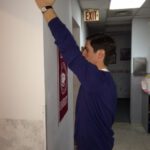
-
Photo 1: Shoulder Overhead Stretch
-
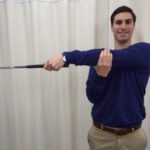
-
Photo 2: Shoulder Chest Cross Stretch
-
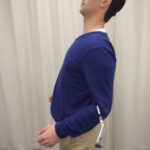
-
Photo 3: Extend Middle and Lower Back Stretch
-

-
Photo 4: Rotate Trunk Standing
-
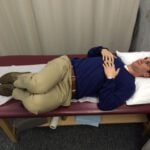
-
Photo 5: Rotate Trunk Lying
-
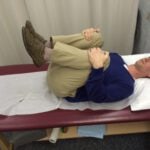
-
Photo 6: Lower Back Flexion Stretch
-
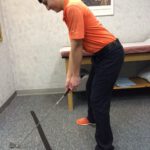
-
Photo 7: Proper Stance
MODELS: John Mackarey, Temple University Doctor of Physical Therapy Student; Frank Cestone, Scranton Prep Golf Team
Visit your doctor regularly and listen to your body.
NEXT MONDAY – Read Dr. Paul J. Mackarey “Health & Exercise Forum" in the Scranton Times-Tribune. Next Week: Back Pain Prevention for Golfers - Part 2 of 3
This article is not intended as a substitute for medical treatment. If you have questions related to your medical condition, please contact your family physician. For further inquires related to this topic email: drpmackarey@msn.com
Paul J. Mackarey PT, DHSc, OCS is a Doctor in Health Sciences specializing in orthopaedic and sports physical therapy. Dr. Mackarey is in private practice and is an associate professor of clinical medicine at The Commonwealth Medical College.
 Every day someone comes to our office with lower back pain (LBP). Often, the person’s primary complaint is that they cannot perform an important daily activity (work, clean, cook, run) because of back pain. However, no group of patients with lower back pain is more eager to recover and return to unrestricted activity than golfers. Dr. Joe Cimochowski and Dr. Dan Sullivan are two good examples of successful return to the sport after spine surgery. I hope this column does not jinx them!
Every day someone comes to our office with lower back pain (LBP). Often, the person’s primary complaint is that they cannot perform an important daily activity (work, clean, cook, run) because of back pain. However, no group of patients with lower back pain is more eager to recover and return to unrestricted activity than golfers. Dr. Joe Cimochowski and Dr. Dan Sullivan are two good examples of successful return to the sport after spine surgery. I hope this column does not jinx them!